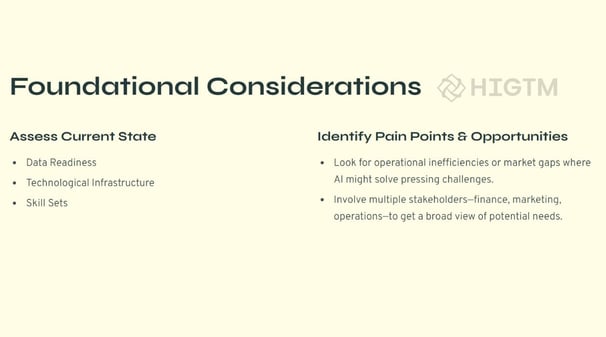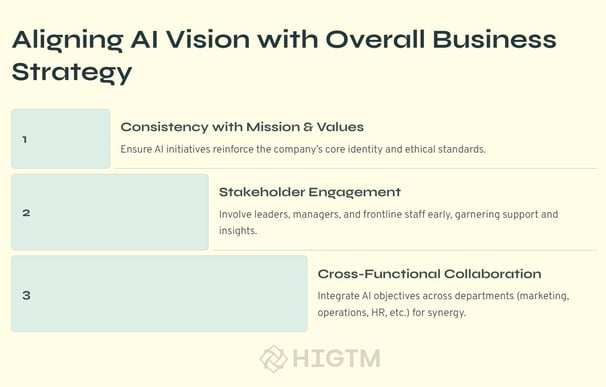10. Building an AI Vision – Setting Strategic Goals
Small and medium-sized enterprises (SMEs) often find themselves asking: “How do we harness AI in a way that genuinely moves the needle?” Many organizations experiment with sporadic AI projects—chatbots here, predictive analytics there—without unifying these efforts around an overarching purpose. This can lead to disjointed results, where tools exist in isolation and never fully drive transformation. The answer lies in developing a clear AI vision—an overarching, strategic plan that aligns data-driven technologies with your broader business objectives. Such a vision doesn’t just identify shiny new tech; it deliberately maps AI efforts to measurable goals and ensures that each initiative ties back to the company’s fundamental mission. This post outlines why a well-defined AI vision is crucial, explores the foundational steps to set the stage, and explains how SMEs can craft—and then implement—strategic AI goals for sustainable impact.
Q1: FOUNDATIONS OF AI IN SME MANAGEMENT - CHAPTER 1 (DAYS 1–31): CORE AI CONCEPTS & VALUE PROPOSITION
Gary Stoyanov PhD
1/10/20255 min read

1. Why an AI Vision Matters
For SMEs, resources—time, budget, and talent—are often stretched thin. An uncoordinated approach to AI can result in wasted efforts and minimal ROI. By contrast, a carefully developed AI vision brings:
Long-Term Direction
AI shouldn’t be a random add-on. When integrated with your core mission, it amplifies strategic goals—like improved customer satisfaction, leaner operations, or new product offerings.
Resource Allocation
Planning AI investments with an end goal in mind prevents scattering funds across multiple small pilots lacking synergy. It enables you to prioritize the highest-value projects and secure leadership support.
Stakeholder Alignment
Team members often fear or misunderstand AI. A unifying vision rallies cross-functional teams around a shared purpose, easing collaboration and fostering a sense of collective ownership over AI’s role.
Bottom Line: A coherent AI vision cements AI as a strategic tool rather than a tactical experiment, ensuring that any technology introduced accelerates the firm’s business ambitions rather than diverting attention.
2. Foundational Considerations
Building an AI vision demands honest reflection on the current state of your data, technology, and human capital. Think of it as laying the groundwork so your AI initiatives stand on a solid, scalable foundation.
2.1 Assess Current State
Data Readiness: Is your data structured, accurate, and accessible?
Data is the lifeblood of AI. Incomplete, disorganized, or siloed data leads to subpar model performance.
Technological Infrastructure: Do your systems support AI workloads, from storage to security?
Cloud solutions can offer scalability without heavy upfront hardware costs.
Skill Sets: What expertise exists among your employees, and do you need external partnerships?
An inventory of internal competencies reveals whether you should invest in training or hire specialized consultants.
2.2 Identify Pain Points & Opportunities
Operational Inefficiencies: Pinpoint repetitive manual tasks, areas of slow turnaround, or chronic errors that erode margins or frustrate staff.
Market Gaps: AI can uncover new revenue streams—like personalized product lines or advanced customer support. Engaging multiple departments—finance, marketing, operations—ensures a broad perspective on potential AI uses.
By thoroughly understanding your current capabilities and most urgent challenges, you eliminate guesswork. This clarity guides where AI might have the most significant immediate benefit while preparing you for future expansion.
3. Crafting Strategic AI Goals
A strong AI vision is action-oriented, built on concrete, realistic goals that reflect your SME’s scale, culture, and resources. Adopting a SMART framework (Specific, Measurable, Achievable, Relevant, Time-Bound) keeps your objectives rooted in realism while pushing for meaningful outcomes.
3.1 SMART Framework
Specific
Example: “Reduce order processing time by 30% within six months.” Vague statements like “Improve operations” don’t guide action.
Measurable
Decide on clear metrics: cost savings, sales lift, error-rate decrease, or customer satisfaction scores.
Achievable
Ambition is great, but ensure it aligns with your available data, talent, and budget.
Relevant
Each objective must serve a critical business function—be it reducing churn or enhancing supply chain efficiency.
Time-Bound
Deadlines sharpen focus and encourage teams to track progress at regular intervals.
Value: The SMART framework forces you to define where AI can truly impact your bottom line or strategic positioning, preventing wanderlust into nebulous, trend-chasing tech projects.
3.2 Prioritize High-Value Areas
Having a laundry list of AI possibilities can paralyze decision-making. Weigh each idea’s ROI potential against its implementation complexity. Then home in on a manageable subset of AI goals where success is likely and the payoff is significant—like automating half your inbound customer queries or predicting product demand more accurately to reduce stockouts.
4. Aligning AI Vision with Overall Business Strategy
An AI vision isn’t separate from your existing strategic plan. Its power comes from synergy—AI initiatives fueling core objectives and vice versa. By ensuring consistent messaging across leadership teams, employees, and customers, you position AI as an enabler rather than a standalone curiosity.
4.1 Consistency with Mission & Values
Ethical Standards: If your SME prides itself on data privacy or personal customer service, adopt AI responsibly—transparent about data use, mindful of bias.
Cultural Fit: Deploying AI that tracks every keystroke might clash with a culture that values employee autonomy. Striking the right balance fosters trust.
4.2 Stakeholder Engagement
Leadership Buy-In: The C-suite or founders should champion the AI vision, providing resources and top-level direction.
Frontline Input: Involve managers and employees early. They know daily pain points and can pinpoint where AI might help the most. Their support often determines project success.
Cross-Functional Collaboration: Complex AI tasks—like predictive maintenance or CRM analytics—span multiple departments. A steering committee or AI champions can coordinate efforts and share learnings across silos.
4.3 Cross-Functional Collaboration
AI typically integrates data from diverse sources—sales logs, warehouse sensors, support tickets. Departments must align on data ownership, formatting, and usage policies. This synergy also helps identify unexpected opportunities, such as linking marketing insights with supply chain constraints to create more targeted campaigns.
5. Roadmap & Next Steps
Armed with a clear vision and SMART objectives, the next challenge is implementing AI in a measured, scalable way that honors budgets and resources. An AI roadmap offers phase-by-phase guidance from proof-of-concept to full operationalization.
5.1 Phased Implementation
Quick-Win Projects
Identify a pilot that can demonstrate early ROI (e.g., automating a simple customer inquiry process or using NLP to route incoming emails).
Early successes attract further investment and enthusiasm.
Complex Initiatives
Once your pilot proves effective, phase in advanced solutions—like predictive maintenance or robust anomaly detection.
Staggering these implementations avoids overwhelming teams and ensures each use case is carefully validated before expansion.
5.2 Resource Planning
Budget
Outline costs for tools, data management, consulting, or staff training. Link expenditures to forecasted benefits (reduced labor hours, higher sales).
Talent & Vendor Partnerships
Decide whether to train in-house staff, hire specialized data scientists, or rely on trusted AI partners.
Technology Upgrades
As AI goals evolve, you may need better data storage solutions, updated ERP software, or integrations between different systems.
5.3 Continuous Review & Refinement
KPI Tracking
Regularly gauge progress against the metrics you defined earlier. If you’re not hitting benchmarks, investigate. Are data feeds inadequate? Does the AI model need retraining?
Emerging Tools & Trends
AI is fluid; new frameworks and best practices arise frequently. Periodic reevaluation ensures your roadmap remains relevant—you might adopt more advanced models or pivot away from a strategy if the market changes.
Iterative Improvements
Translate user feedback into model enhancements, add new data sources, or extend successful pilots to other departments.




6. Harnessing the Power of AI + Automation
Designing a clear AI vision—and setting strategic goals—forms the backbone of any successful AI initiative. Rather than dabbling in random pilots or chasing trends, SMEs that align AI efforts with tangible business objectives typically see faster, more meaningful results. The key is to start where it counts—with thorough readiness assessments, well-chosen use cases, and a structured roadmap that scales over time.
Key Takeaways:
Foundation First: Understand data, technology, and skill capacity before overcommitting to advanced AI.
Clarity in Goals: SMART targets ensure your AI deployment remains focused, measurable, and directly tied to mission-critical outcomes.
Phased Approach: Incremental rollouts drive quick successes, build momentum, and mitigate risks associated with major transformations.
Stakeholder Alignment: Continuous communication and cross-team engagement improve adoption and overcome cultural barriers.
Adapt & Refine: AI is never a one-and-done solution; regular re-evaluation and model updates keep it aligned with shifting business landscapes.
When crafted thoughtfully, an AI vision isn’t just a tech plan—it’s a strategic guide that powers your SME’s next level of growth, competitiveness, and innovation. By setting goals that align with your core values and operational realities, you infuse purpose into AI projects, unifying teams around a shared aspiration: to leverage data-driven insights and automation for sustainable, forward-looking success.
If you need help structuring your AI vision—defining objectives, assessing feasibility, or mapping a progressive roadmap—HIGTM specializes in tailored AI consultations for SMEs.
Every big AI success starts with clear direction and smart, strategic goals.
Turn AI into ROI — Win Faster with HIGTM.
Consult with us to discuss how to manage and grow your business operations with AI.
© 2025 HIGTM. All rights reserved.
